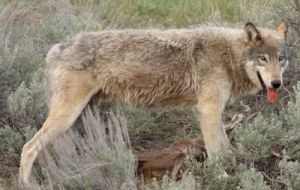MercoPress. South Atlantic News Agency
How scientists cracked puzzle of the Falklands wolf
 Darwin in 1824 when visiting the Islands said he was surprised by the unusual tame nature of the reddish fur wolf
Darwin in 1824 when visiting the Islands said he was surprised by the unusual tame nature of the reddish fur wolf The origin of the mysterious Falkland Islands wolf, which was persecuted to extinction in the late 19th century, may finally have been solved, 175 years after Charles Darwin puzzled over the nature of this curious fox-like creature, according to a piece written by The Independent Science editor Steve Connor on the Monday edition.
A DNA analysis of four stuffed museum specimens has revealed that the wolf did not, as previously thought, come to the Falklands as the pets of early South American natives who voyaged to the islands, but traveled there long before humans had populated the Americas.
The genetic study of tissue samples taken from the four stuffed specimens has revealed that they last shared a common ancestor more than 70,000 years ago, showing that the species must have come to the Falklands long before the end of the last ice age.
But even though the study has gone some way to clarifying the evolutionary origins of the Falklands wolf, the species still represents a great bio-geographical conundrum because the Falklands have never been connected to the South American mainland and no other land mammals – not even small rodents – have managed to live there.
“It is really strange that the only native mammal on an island would be a large canid. There are no other native terrestrial mammals, not even a mouse,” said Graham Slater of the University of California, Los Angeles, whose DNA analysis of the Falklands wolf is published in the journal Current Biology.
“It’s even stranger when you consider that the Falklands are 480 kilometers from the South American mainland. The question is, how did they get there?”
When Darwin wrote about the wolf in 1834 during his travels on HMS Beagle, he noted how peculiar it was for such a large animal to be living on a remote archipelago. He also commented on its unusually tame nature, which led others to speculate that the animals must be the descendents of escaped pets brought to the archipelago by natives.
The wolves grow to the size of coyotes or larges foxes, but are much stockier with thick, reddish fur and short muzzles, rather like grey wolves. Little is known about their behavior but they probably lived off nesting ground birds, seal pups, insects and other grubs.
The DNA study found that the closet living relative of the Falkland Islands wolf, Dusicyon australis, is the manned wolf, an unusually long-legged, fox-like canid that lives on the South American mainland. But they last shared a common ancestor some 6 million years ago, Dr Slater said. “Canids don’t show up in the South American fossil record until 2.5 million years ago, which means these lineages must have evolved in North America. The problem is that there are no good fossils that can be assigned to the Falklands wolf lineages in North America,” he said.
Another close relative of the Falklands wolf is likely to be a canid species, called Dusicyon avus, which lived in Patagonia but went extinct about 7,000 years ago, Dr Slater said.
The Falklands wolf quickly went extinct after Europeans arrived on the Islands from the 17th century. The last wolves are believed to have been killed in the 1870s by sheep farmers.




Top Comments
Disclaimer & comment rulesCommenting for this story is now closed.
If you have a Facebook account, become a fan and comment on our Facebook Page!